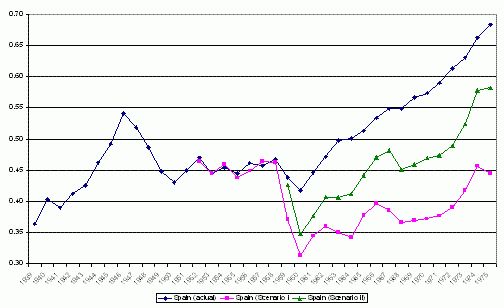Since the early 1980s, many developing countries have undergone major economic policy reforms following the so-called “Washington Consensus” – including measures to liberalise trade and capital flows, reduce inflation and fiscal imbalances, cut down inefficient government activity, and to protect property rights. But empirical studies based on cross-country regressions suggest that these reforms may not have had the desired benefits (Easterly 2005). The debate continues.
New evidence from Franco’s Spain
In a recent CEPR working paper (Prados de la Escosura et al. 2010) we hope to provide a longer-run dimension to the ongoing debate. We argue that the Spanish reforms programme of 1959, under Franco’s dictatorship, can be seen as a forerunner of the Washington Consensus and therefore provides a good test for the effectiveness of its “basic” set of policies. This adds a new set of data from which to evaluate the consequences of liberalisation and stabilisation programmes.
A cautious liberalisation – in a dictatorship
From 1950 to 1975 Spain evolved from a closed and isolated economy to integrating with the rest of European economies, albeit remaining as a dictatorship. After the Civil War (1936-39), the new autocratic regime introduced anti-market policies that dramatically altered the previous economic policy. Effective possession of legislative and judicial powers gave General Franco’s dictatorship the ability to alter economic and political rights without restraint. These new measures resulted in high inflation rates, the development of black markets, and a severe contraction of international trade.
In the early 1950s, some of these regulations were relaxed and a cautious liberalisation process began. The new international context dominated by the Cold War helped decisively to rehabilitate the regime of General Franco in the international community. Growth accelerated during the 1950s on the basis of capital accumulation and efficiency gains. The US-Spain cooperation agreements in 1953 helped to further the growth in economic confidence (Calvo-González 2007).
In July 1959, an inward-looking growth crisis, triggered by a dramatic shortage of foreign reserves, led a new technocratic cabinet to introduce a simultaneous liberalisation of domestic markets and international economic relations. Following advice from the IMF and the Organisation for European Economic Cooperation, a conventional stabilisation programme was enforced.
- First, a stabilisation operation was executed to reduce inflation, mainly due to a lack of monetary discipline. Public spending was controlled, the issue of new public debt limited, and the Bank of Spain’s rate of discount increased.
- Second, domestic markets were partly liberalised by suppressing regulations and simplifying administrative procedures.
- Third, authorities partly liberalised foreign trade and the Peseta was integrated into the Bretton Woods system, accompanied by the introduction of a more realistic exchange rate, while restrictions on foreign direct investment were relaxed.
All major contingency measures were successful. Inflation declined, the budget deficit disappeared, and foreign capital began to flow into the country. By implementing the new policy, Franco’s regime showed its commitment to orthodox macroeconomic policies and offered a precedent of responsible behaviour to domestic and foreign investors.
Pinpointing causality
A fundamental problem in analysing the impact of economic reforms is the interconnection between distinctive policies often implemented simultaneously. For this reason, an index of macroeconomic distortions was developed. This index tries to capture the basic features of macroeconomic policies that could influence economic performance while avoiding cross-correlation problems between different policy indicators. This measure was chosen because it captures distortions that characterised of Franco’s economic policy such as the depreciation rate of the currency and the sizeable black market.
Figure 1. Index of macroeconomic distortions 1939-75
Sources: Prados de la Escosura et al. (2010).
The index of macroeconomic distortions significantly increased up to 1947 where it stayed in a high plateau until a gradual decline started in 1951 and was sustained during the 1950s. Only an episodic reversal took place in 1956, associated to populist policies which led to a substantial pay rise across the board in 1956 and a subsequent inflation upsurge. From then on, the index remained stable at low values until it rose again after the 1973 oil shock. The index therefore is a close reflection of the qualitative evidence presented above.
Our econometric analysis confirms the importance of the economic policy reforms during the early 1950s and, particularly, by the 1959 Liberalisation and Stabilisation Plan. These policies helped achieve sustained growth, primarily through gains in total factor productivity.
The 1959 Plan gave way to a new institutional set up which favoured the allocation of resources along comparative advantage and allowed accelerating growth and catching up. Without the 1959 Plan, GDP per head would have been significantly lower at the time of General Franco’s death in 1975. However, there is a significant difference in outcomes depending on whether pre-1951 macroeconomic economic distortions had remained in place (that is, with no economic reforms at all) or if only the 1959 Plan had not been implemented and the 1950s restrictions persisted. In fact, by 1975, per capita GDP would have represented two-thirds of its actual level in the first scenario, but 85% in the second (figure 2).
Figure 2. Spain’s relative per capita GDP: Actual and counterfactual, 1939-75 (Western Europe 12 = 1)
Sources: Prados de la Escosura et al. (2010). Notes: Western Europe (12) is a population weighted average of Austria, Belgium, Denmark, Finland, France, Germany, Italy, Netherlands, Norway, Sweden, Switzerland, and UK.
Several broad lessons could be derived from this historical investigation. Major economic reforms seem more successful when they occur after a period of initial reforms and growth. It seems unlikely that the Spanish Stabilisation Plan would have succeeded without previous policy reforms and economic growth. Some similarities can be suggested between 1959 Spanish Stabilisation and the Marshall Plan as, in both cases, success depended on the fact that the countries involved were growing already and their governments were opening up the economy reassuring economic agents about their commitment to free markets and international integration (De Long and Eichengreen 1991). Our results confirm that successful stabilisation programs are possible under authoritarian political regimes.
Conclusions
No simple analogies can be drawn, however, between Spain’s historical experience and similar reforms to be implemented in developing countries.
The main lesson is, perhaps, that the economic results of any major stabilisation programme depend, to a large extent, on the historical context.
- Particular historical circumstances eased Spanish economic reforms.
- The Cold War allowed the co-existence of a dictatorial regime in Western Europe with a market-oriented and internationally integrated economy. In particular, it made easier for Franco’s regime to get foreign economic assistance and substantial loans to finance its economic reforms.
- The nature of the Bretton Woods system, which restricted speculative capital movements, helped the reform process.
- Furthermore, in the 1950s and 1960s the prospects for faster growth were facilitated by new technology with large potential total factor productivity gains, which was put in hands of Spanish firms by foreign investors.
References
Calvo-González, Oscar (2007), “American Military Interests and Economic Confidence in Spain under the Franco Dictatorship”, Journal of Economic History, 67: 740-767
Easterly, William (2005), “National Policies and Economic Growth: A Reappraisal”, in Philippe Aghion and Steven Durlauf (eds.), Handbook of Economic Growth, Amsterdam: Elsevier.
De Long, J Bradford and Barry Eichengreen (1991), “The Marshall Plan: History of the Most Successful Structural Adjustment Program”, NBER Working Paper 3899.
Prados de la Escosura, Leandro, Joan R Rosés, and Isabel Sanz Villarroya (2010), “Stabilization and Growth under Dictatorship: The Experience of Franco’s Spain”, CEPR Working Paper 7331.







